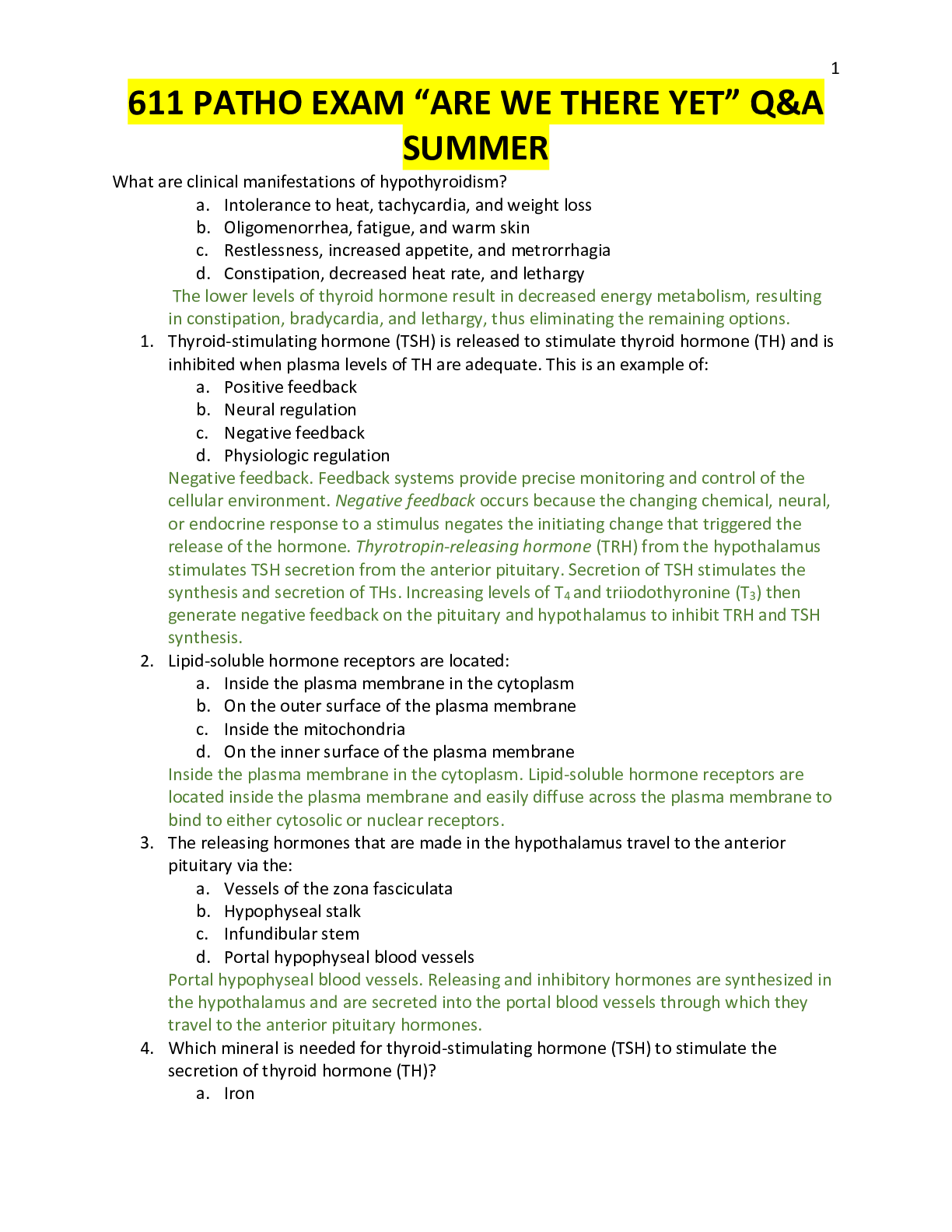*NURSING > QUESTIONS & ANSWERS > 611 PATHO EXAM “ARE WE THERE YET” Q&A SUMMER 100% questions and aswers (All)
611 PATHO EXAM “ARE WE THERE YET” Q&A SUMMER 100% questions and aswers
Document Content and Description Below
611 PATHO EXAM “ARE WE THERE YET” Q&A SUMMERWhat are clinical manifestations of hypothyroidism?a.Intolerance to heat, tachycardia, and weight lossb.Oligomenorrhea, fatigue, and warm skinc.Restless... ness, increased appetite, and metrorrhagiad.Constipation, decreased heat rate, and lethargyThe lower levels of thyroid hormone result in decreased energy metabolism, resulting in constipation, bradycardia, and lethargy, thus eliminating the remaining options.1.Thyroid-stimulating hormone (TSH) is released to stimulate thyroid hormone (TH) and is inhibited when plasma levels of TH are adequate. This is an example of:a.Positive feedbackb.Neural regulationc.Negative feedbackd.Physiologic regulationNegative feedback. Feedback systems provide precise monitoring and control of the cellular environment. Negative feedback occurs because the changing chemical, neural, or endocrine response to a stimulus negates the initiating change that triggered the release of the hormone. Thyrotropin-releasing hormone (TRH) from the hypothalamus stimulates TSH secretion from the anterior pituitary. Secretion of TSH stimulates the synthesis and secretion of THs. Increasing levels of T4 and triiodothyronine (T3) then generate negative feedback on the pituitary and hypothalamus to inhibit TRH and TSH synthesis.2.Lipid-soluble hormone receptors are located:a.Inside the plasma membrane in the cytoplasmb.On the outer surface of the plasma membranec.Inside the mitochondriad.On the inner surface of the plasma membraneInside the plasma membrane in the cytoplasm. Lipid-soluble hormone receptors are located inside the plasma membrane and easily diffuse across the plasma membrane to bind to either cytosolic or nuclear receptors. 3.The releasing hormones that are made in the hypothalamus travel to the anterior pituitary via the:a.Vessels of the zona fasciculatab.Hypophyseal stalkc.Infundibular stemd.Portal hypophyseal blood vesselsPortal hypophyseal blood vessels. Releasing and inhibitory hormones are synthesized in the hypothalamus and are secreted into the portal blood vessels through which they travel to the anterior pituitary hormones. 4.Which mineral is needed for thyroid-stimulating hormone (TSH) to stimulate the secretion ofthyroihormonea.Ironb.Iodidec.Zincd.Copperodide. TSH, which is synthesized and stored in the anterior pituitary, stimulates secretion of TH by activating intracellular processes, including the uptake of iodine necessary for the synthesis of TH. 5.What effect does hyperphosphatemia have on other electrolytes?a.Increases serum calciumb.Decreases serum magnesiumc.Decreases serum calciumd.Increases serum magnesiumDecreases serum calcium. Hyperphosphatemia leads to hypocalcemia. Remember that phos and calcium are inversely related.6.Insulin transports which electrolyte in the cell?a.Potassiumb.Sodiumc.Calciumd.PhosphorusPotassium. Insulin facilitates the intracellular transport of potassium, phosphate, and magnesium. 7.Which second messenger is stimulated by epinephrine binding to a β-adrenergic receptor?a.Calciumb.Inositol triphosphate (IP3)c.Diacylglycerol (DAG)d.Cyclic adenosine monophosphate (cAMP)Cyclic adenosine monophosphate (cAMP). Second-messenger molecules are the initial link between the first signal (hormone) andthe inside of the cell. For example, the binding of epinephrine to a β adrenergic–receptor subtype activates (through a stimulatory G protein) the enzyme, adenylyl cyclase. Adenylyl cyclase catalyzes the conversion of adenosine triphosphate (ATP) to the second messenger, 3', and 5'-cAMP. 8.Regulation of the release of catecholamines from the adrenal medulla is an example of which type of regulation?a.Negative feedbackb.Neuralc.Positive feedbackd.PhysiologicNeural. The release of hormones occurs either in response to an alteration in the cellular environment or in the process of maintaining a regulated level of certain hormones or certain substances. Several different mechanisms, one of which is neural control (e.g., stress-induced release of catecholamines from the adrenal medulla), regulate the release of hormones9.Which hormone does the second messenger calcium (Ca++) bind to activate phospholipase C through a G protein?a.Angiotensin IIb.Estrogenc.Thyroxined.TestosteroneAngiotensin II. Ca++ is considered an important second messenger that facilitates the binding of a hormone (e.g., norepinephrine, angiotensin II) to a surface receptor, activating the enzyme phospholipase C through a G protein inside the plasma membrane. [Show More]
Last updated: 1 year ago
Preview 1 out of 31 pages
Instant download

Buy this document to get the full access instantly
Instant Download Access after purchase
Add to cartInstant download
Reviews( 0 )
Document information
Connected school, study & course
About the document
Uploaded On
Mar 11, 2021
Number of pages
31
Written in
Additional information
This document has been written for:
Uploaded
Mar 11, 2021
Downloads
0
Views
25


